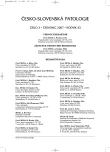A Case of Excessive Autophagocytosis with Multiorgan Involvement and Low Clinical Penetrance
Authors:
J. Sikora 1; L. Dvořáková 1; H. Vlášková 1; L. Stolnaja 1; J. Betlach 2; J. Špaček 3; M. Elleder 1
Authors‘ workplace:
Institute of Inherited Metabolic Disorders, 1st Medical Faculty, Charles University and
General Teaching Hospital, Prague, Czech Republic
1; Department of Pathology, Hospital Havlíčkův Brod, Czech Republic
2; The Fingerland Department of Pathology, Faculty of Medicine in Hradec Králové
Charles University, Czech Republic
3
Published in:
Čes.-slov. Patol., 43, 2007, No. 3, p. 93-103
Category:
Original Article
Overview
An autopsy and microscopic analyses of a 74-year-old female with a clinical history of cardiac hypertrophy and hypertension disclosed a pronounced distension of lysosomal compartment with signs of excessive autophagocytosis, predominantly in cardiomyocytes, hepatocytes and smooth muscle cells of the small intestine. The histological storage pattern did not correspond to the usual changes seen in defined lysosomal storage disorders. The amount of age-related lipopigment was low in all tissues. Confocal microscopy of liver tissue samples documented a progressive loss of mitochondrial epitopes in the distended lysosomal compartment along the porto-central axis of hepatic lobules. The possibility to detect subunit c of mitochondrial ATP synthase (SCMAS) indicated extensive intra-lysosomal degradation of mitochondria, both in hepatocytes and smooth muscle cells. The SCMAS epitope can thus be considered a valuable immunohistochemical marker of autophagocytic mitochondrial degradation. The distended lysosomes also displayed tissue specific ubiquitination. Absence of immuno-detectable p62 protein excluded aggresome formation. An inherent dysfunction of the late endosomal/lysosomal LAMP2 protein (Danon disease), was excluded on the basis of LAMP2 gene sequence analysis and LAMP2 protein levels. Whether the observed process reflects a primary dysregulation of the constitution of the autophagosomal membrane or was induced by defects in other cellular components, remains unanswered. Whatever mechanism involved, the findings should be considered relevant in differential diagnostics, despite their low clinical penetrance, should be registered and thus rendered available for future definition.
Key words:
autophagocytosis – cardiomyopathy – hepatopathy – lysosomes - subunit C of mitochondrial ATP synthase
Labels
Anatomical pathology Forensic medical examiner ToxicologyArticle was published in
Czecho-Slovak Pathology

2007 Issue 3
Most read in this issue
- The Autopsy of Reinhard Heydrich
- Expression of E-cadherin and c-erbB-2/HER-2/neu Oncoprotein in High-Grade Breast Cancer
- Pleomorphic Epithelioid/Clear Cell Malignant Tumor of the Uterus Exhibiting both Myoid and Melanocytic Differentiation – Leiomyosarcoma or PEComa? A Case Report and a Review of the Literature
- Bloch-Sulzberg Syndrome in Pathology
